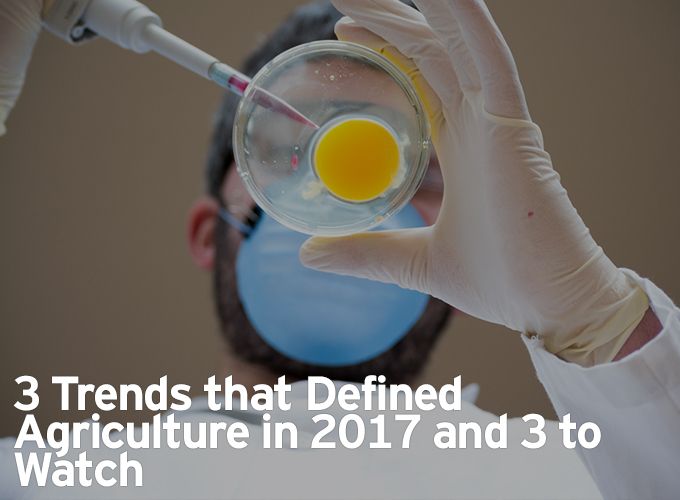Last year recorded groundbreaking technological advances in agriculture, even as the ag giants focused on consolidation. In looking back over the trends that shaped 2017, we can locate the signs pointing to the big stories we anticipate this year.
Michael Helmstetter | TechAccel
Last year recorded groundbreaking technological advances in agriculture, even as the ag giants focused on consolidation. In looking back over the trends that shaped 2017, we can locate the signs pointing to the big stories we anticipate this year.
Defining 2017
The Democratization of Gene Editing
2017 was the year that democratized gene editing. The simplicity and affordability of this invention make its potential impact hard to overstate. Backed by the power of big data platforms, CRISPR represents the biggest opportunity yet to create custom-trait products, precision-nutrient value foods, safer oral vaccines for animals and other advances not yet imagined.
Not surprisingly, the year of CRISPR was also marked by legal wrangling over the ambiguous ownership of the invention—dubbed by some as the biotech patent fight of the century—including the development of new consortia to address ownership.
Microbiome in Bloom
Microbiome research and investments heated up in 2017, setting off a race to create new biological products targeting soil health as much as human health. Indigo became a unicorn ($1B valuation) in 2017 and other notable startups include EpiBiome, AgBiome, New Leaf Symbiotics and Inocucor among the growing list.
Additionally, federal funding may have launched the trend with the Human Microbiome Project, but as research continues to reveal the profound effect bacteria have on their ecosystems, VCs are staking out opportunities to capitalize on the power of these microorganisms in pharma, agriculture, animal health, food and beyond.
A Year of the Mega-Merger
In another year of difficult commodity pricing, the big ag players pursued efficiencies through unprecedented consolidations. M&A activity between Syngenta and ChemChina, Monsanto and Bayer and Dow Chemical and DuPont shattered records, coming in with price tags two to three times higher than those of the past decade.
Looking Ahead to 2018
When the M&A Dust Settles
As the Big Six become the Big Three or Four, expect to see R&D budgets trimmed and more reductions in force. This is going to make waves of qualified researchers available in the marketplace for hire by startups. You’ll also see some of these researchers remake themselves into entrepreneurs with new startups, as well as subject matter experts for hire. There is a lot of talent in agriculture available right now, which means we’re looking for a lot of new ideas to sprout in unexpected places.
Empowering the Consumer
More and more consumers are demanding clear provenance for the food they purchase: proof that their animals are treated humanely, that their produce is contaminant-free or organic, that their fish are sustainably caught. This could make 2018 the year of the ag blockchain. We expect blockchain technology to be applied throughout the ag ecosystem, all across the value chain, to produce immutable traceability and generate trust with every step in the production system.
Furthermore we expect mobile tech, sensors and IoT infrastructure to be repurposed into these new blockchains, as we are already starting to see in fish marketing, farm animals and produce. The technology will help meet transparency in labeling guidelines and satisfy consumers who want traceability.
It is still unclear where the investment and return will come from for ag blockchain. We see in several areas of ag financing the push toward the consumer is already underway. There’s a growing recognition of the greater value creation later in the product lifecycle and at closer proximity to the consumer. We expect to see more cash flowing toward fruits, nuts and vegetables–self-contained products ready for the consumer–as opposed to the big row crops.
And for true locavores, the grow-your-own trend might come home to roost with new business models that can start small but have the potential to scale. Last in the empowered consumer realm, look for new farms (think indoor, vertical, hydroponic) to change our thinking about who can farm and where.
More Machine Learning
Underlying all of these advances, we expect to see continued growth in intelligent databases and their applications first in simulations, then in the real world. Think of cloud biology–the plethora of genomic data that can be massaged and developed with artificial intelligence and machine learning. 2018 will boast a raft of new data tools andplatforms, everything from Watson to open-source public data platforms. With the cost of cloud computing set to keep dropping, even as precision ag brings more and more data-gathering sensors onto the Internet of Things, the innovators in this space could come from anywhere, so keep your eyes open.
The advances of 2017 kicked open the doors of opportunity in agriculture. In 2018, we’ll look for those with the best talent, the best consumer focus and the best analytics to walk through them.
The content & opinions in this article are the author’s and do not necessarily represent the views of AgriTechTomorrow
Comments (0)
This post does not have any comments. Be the first to leave a comment below.
Featured Product


